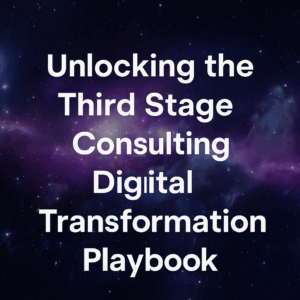By: Eric Kimberling

Table of Contents
ToggleThe Journey and Challenges of Go-Live
As the CEO of Third Stage Consulting, I’ve guided clients through the crucial phase of digital transformation: the go-live stage. This period, while filled with excitement, is often laden with challenges that can make or break the success of the implementation.
What is Go-Live?
“Go-live” is a term commonly used in the context of information technology, particularly during the implementation of new software systems, digital transformations, or large-scale IT projects. It refers to the moment when a system or solution becomes officially operational and available for its intended users or business operations. Here’s a breakdown of what go-live typically involves:

Definition and Key Characteristics
- Transition to Production: Go-live marks the transition from a development or testing phase to a production environment where the system is actively used in real-world scenarios.
- End of Implementation: It signifies the end of the implementation phase of a project, where planning, development, testing, and training phases are considered complete.
- Start of Operational Use: This is the point when the system starts being used by its intended users for its intended purpose in the daily operations of a business.
Importance in IT and Business Projects
- Milestone Event: Go-live is a critical milestone in IT and business projects, indicating that the project has reached a stage of completion where it’s ready for everyday use.
- User Adoption: It’s a crucial time for user adoption, as this is when users begin to engage with the new system in their regular work environment.
- Operational Impact: The success of the go-live can significantly impact business operations, either positively by enhancing processes and efficiency or negatively if there are significant issues or disruptions.
Challenges and Considerations
- Preparation: Extensive preparation is crucial, including thorough testing, user training, data migration, and ensuring all systems and processes are aligned for the new change.
- Risk Management: Identifying and mitigating risks before going live is vital to avoid operational disruptions, technical failures, or user resistance.
- Support and Monitoring: After going live, continuous support and monitoring are necessary to address issues, provide user assistance, and ensure system stability.
Phases Around Go-Live
- Pre-Go-Live: Involves final testing, user training, data migration, and final checks to ensure everything is in place.
- The Go-Live Event: Actual switch-over to the new system. This may involve a specific moment where systems are switched or a phased approach.
- Post-Go-Live: Focuses on support, resolving emerging issues, and optimizing the system based on real-world use.
Go-live is more than just a technical milestone; it’s a significant business event that marks the changeover from old to new systems, involving both technological and human elements. Its success is not just in the technical deployment but also in how well users adapt to and utilize the new system in achieving business goals.
Insights into the Go-Live Phase: Risks and Strategies for Mitigation

The Reality of Operational Disruption
In my experience, over half of the organizations encounter significant operational disruptions during go-live. These aren’t just minor hiccups; we’re discussing major issues like failing to ship products or run payroll. The objective here isn’t to eliminate these challenges entirely but to understand and effectively manage them.
The Importance of Training
One of the main reasons for operational disruption is inadequate training. It’s not uncommon to see employees struggling with new systems because they weren’t trained adequately or because they find the real-time environment more challenging than anticipated. I recommend a comprehensive, iterative training approach to combat this, ensuring employees are fully comfortable with new processes and systems.
Data Challenges: A Common Stumbling Block
Data migration and management are pivotal yet challenging aspects of go-live. I always advise starting data cleanup and migration processes early and ensuring testing involves real data and volumes. Equally important is establishing strong data governance to maintain data integrity post-implementation.
Security Profile Setup: A Critical Step
A frequent issue during go-live is users being locked out of parts of the system they need due to improperly set up security profiles. This can be avoided by thoroughly testing and vetting security profiles before going live.
Dealing with Technology Flaws
Although not as common as other challenges, issues with the technology itself can arise. It’s essential to be prepared for potential modifications post-go-live. This includes being ready to adjust the system to ensure optimal performance in a real-life environment.
Pre-Go-Live Assessments: The Go/No-Go Decision
An essential part of preparing for go-live is conducting go/no-go assessments. These are crucial for understanding the readiness and risks associated with the go-live. I strongly believe in the importance of having an independent third-party advisor for an objective assessment, which should evaluate technical readiness and operational and training readiness.
Conclusion: Embracing Realism and Preparedness
From my professional journey and experiences with numerous clients, it’s clear that being realistically prepared for the go-live phase is crucial. While it’s a time of great anticipation, recognizing and preparing for the potential challenges is key. Ultimately, the goal is to navigate this critical phase with a well-planned strategy, focusing on comprehensive training, effective data management, meticulous security configuration, and thorough readiness assessments to ensure a successful digital transformation journey.
If you have any questions or want to have an informal discussion about what to expect during go-live, please feel free to reach out to me directly at Eric.Kimberling@ThirdStage-Consulting.com. I also highly recommend downloading our 2024 Digital Enterprise Operations Report and following our weekly podcasts or YouTube channel for more on the holistic approach to business technology.





